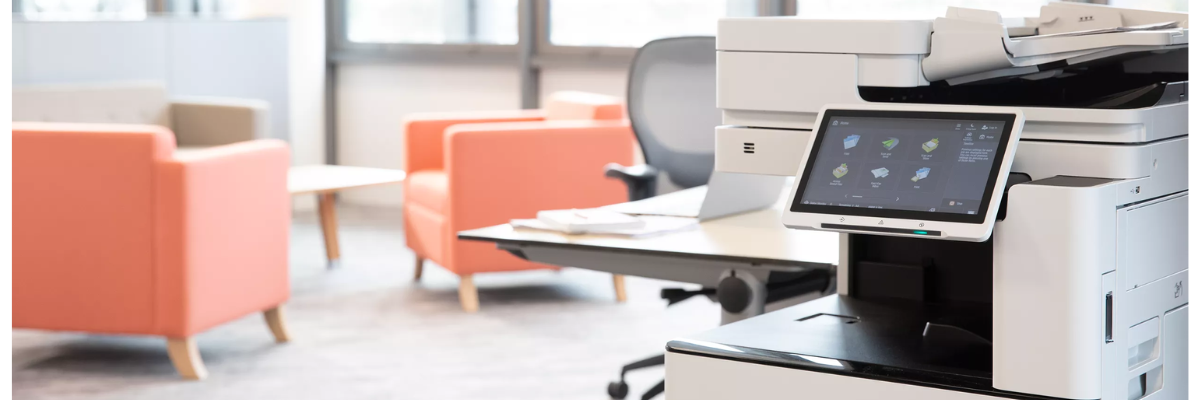By: Jada Sterling, Digital Content Manager on September 21st, 2023
Healthcare Data Breaches: Does Your Printer Put You At Risk?
Of all the devices that we know can be hacked, you might not have considered your printer to be one of them. However, as printers become more advanced and able to connect to other devices, this poses a risk of cyber attacks. This is especially true for small-to-medium-sized healthcare businesses. Unsurprisingly, they are being targeted now more than ever due to the sensitive patient data they deal with.
The “Internet of Things” and How it Can Lead To A Healthcare Data Breach
Sean Hope, Director of MPS at Usherwood Office Technology, says the digital world has created countless new avenues for cyberattacks. He says the “Internet of Things” is a major factor in network security risks in the last several years.
“Whether it’s your refrigerator, or your thermostat, or your desktop all-in-one printer/fax/scanner, these things are all connected,” said Hope.
These devices are often connected to more crucial devices on your network, so hackers are taking advantage of it, Hope says. Printers are no exception, so cybersecurity is a big factor when talking about healthcare print management.
“[Hackers are] using them as points of ingress to get into the networks, to get a foothold in that network. Because these devices aren’t necessarily designed with as many security features as you would see in a laptop or a server, or a PC,” Hope said.
Types of Healthcare Data Breaches & Attacks
All the new devices used in healthcare make easy targets for hackers to get into networks that contain sensitive information. When cybercriminals are able to breach your networks, they can potentially:
- Shut down crucial networks for patient care
- Take hold of systems like HVAC, security systems and more
- Release private, HIPAA-protected information to the public
Despite all the devices that pose security risks, the biggest risk to your organization is still human error. This is why it’s essential to talk to your staff about cybersecurity. Make sure to conduct training on properly storing and managing data, and ensure they know the do’s and don’ts of cybersecurity. Hope gave an example of how easily malware can get into a business network when employees work from home and use off-network devices.
“Say your kid works on his school project at home and he has it saved on a thumb drive and he plugs it into your home all-in-one [printer]. Now, thumb drives are notorious for collecting malware. All of a sudden, you’ve infected that home device, which [your PC] is connected to,” Hope said. You might even bring that thumb drive into work with you to transfer files.
“When you go into work, you’re plugging that in, and things are getting behind the firewall that way,” Hope went on.
Assess Your Healthcare Printing System
When evaluating your cybersecurity defenses, you should look at your current printer fleet and ensure they’re updated with the latest software patches. These patches are designed to ward off specific new cyber threats as they’re discovered. Sometimes, when printer manufacturers release new printer models, older ones can’t be patched like newer models. This makes older models vulnerable to attackers.
Many manufacturers have online guides or apps to walk you through updating the device. You’ll be able to see the models compatible with the update through this process, so you can determine if it’s time to upgrade to new devices.
What to Look For When Buying a Printer
With the rise of “zero-day attacks” or brand-new attack methods that existing security systems are unfamiliar with, it’s more important than ever to upgrade your business’ devices to be prepared.
Not all printers are created equal. The main thing to look for when purchasing printers for healthcare is devices that are secure by design. Hope recommends enterprise class devices, such as the LaserJet Managed E40040, that offer unique security features like Memory Shield™. As an exclusive feature in HP printers, Memory Shield™ works to actively monitor the system against zero-day cyber attacks.
After a potential attack is detected, the printer will even self-heal and reboot to a safe state. This is an automatic feature and cannot be disabled by attackers.
This is just one example of the advanced security features present on the market. Although cyber attacks can be scary, this is one way you can take the initiative to protect your business from potential data loss.
Consequences of Compromised Healthcare Data Security
Once attackers take hold of a healthcare business’ network, they can cause catastrophic damage to an organization. They can disrupt patient care, leak protected patient information that leads to lawsuits, and destroy the community's trust in your business. What’s worse, patients can suffer as a result of data loss and exposure, so it’s essential to take necessary prevention measures.
Make sure to look into finding a knowledgeable team familiar with cybersecurity to help you protect your healthcare business.
Read On

How HP Printers and Toner Cartridges Will Drastically Improve Your Printer Security
HP is a leading print manufacturer in endpoint security. Their printers offer a unique set of...

Top 4 Cybersecurity Tools To Look For In A Business Printer
If you’re trying to improve your cybersecurity strategy, ensure you don't overlook your printers....

Bring Your Own Device (BYOD) Policies: Benefits and Risks
When deciding on what technology to use for business activities, it can be tempting to opt for a...



